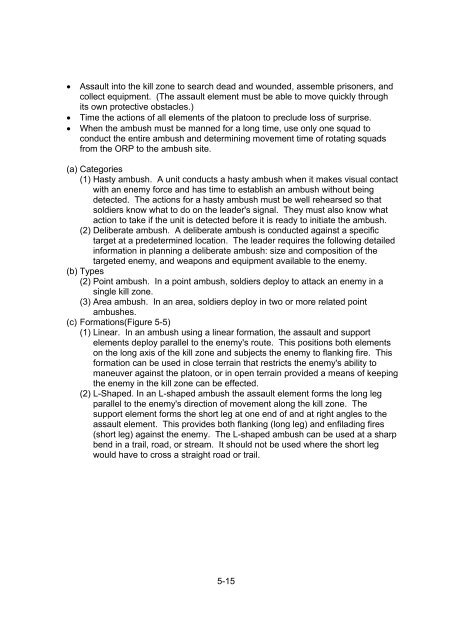Create successful ePaper yourself
Turn your PDF publications into a flip-book with our unique Google optimized e-Paper software.
• Assault into the kill zone to search dead and wounded, assemble prisoners, and<br />
collect equipment. (The assault element must be able to move quickly through<br />
its own protective obstacles.)<br />
• Time the actions of all elements of the platoon to preclude loss of surprise.<br />
• When the ambush must be manned for a long time, use only one squad to<br />
conduct the entire ambush and determining movement time of rotating squads<br />
from the ORP to the ambush site.<br />
(a) Categories<br />
(1) Hasty ambush. A unit conducts a hasty ambush when it makes visual contact<br />
with an enemy force and has time to establish an ambush without being<br />
detected. The actions for a hasty ambush must be well rehearsed so that<br />
soldiers know what to do on the leader's signal. They must also know what<br />
action to take if the unit is detected before it is ready to initiate the ambush.<br />
(2) Deliberate ambush. A deliberate ambush is conducted against a specific<br />
target at a predetermined location. The leader requires the following detailed<br />
information in planning a deliberate ambush: size and composition of the<br />
targeted enemy, and weapons and equipment available to the enemy.<br />
(b) Types<br />
(2) Point ambush. In a point ambush, soldiers deploy to attack an enemy in a<br />
single kill zone.<br />
(3) Area ambush. In an area, soldiers deploy in two or more related point<br />
ambushes.<br />
(c) Formations(Figure 5-5)<br />
(1) Linear. In an ambush using a linear formation, the assault and support<br />
elements deploy parallel to the enemy's route. This positions both elements<br />
on the long axis of the kill zone and subjects the enemy to flanking fire. This<br />
formation can be used in close terrain that restricts the enemy's ability to<br />
maneuver against the platoon, or in open terrain provided a means of keeping<br />
the enemy in the kill zone can be effected.<br />
(2) L-Shaped. In an L-shaped ambush the assault element forms the long leg<br />
parallel to the enemy's direction of movement along the kill zone. The<br />
support element forms the short leg at one end of and at right angles to the<br />
assault element. This provides both flanking (long leg) and enfilading fires<br />
(short leg) against the enemy. The L-shaped ambush can be used at a sharp<br />
bend in a trail, road, or stream. It should not be used where the short leg<br />
would have to cross a straight road or trail.<br />
5-15


